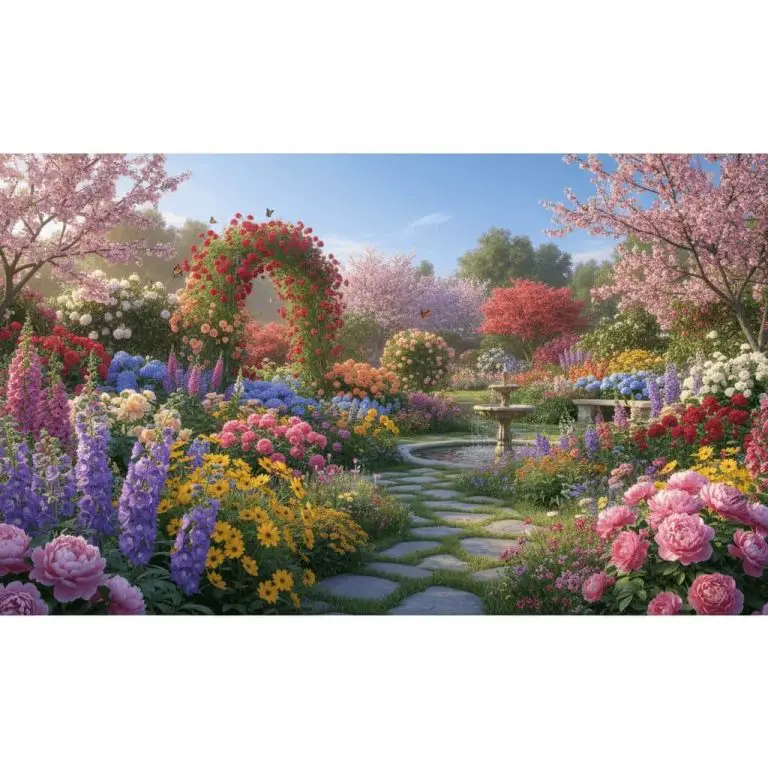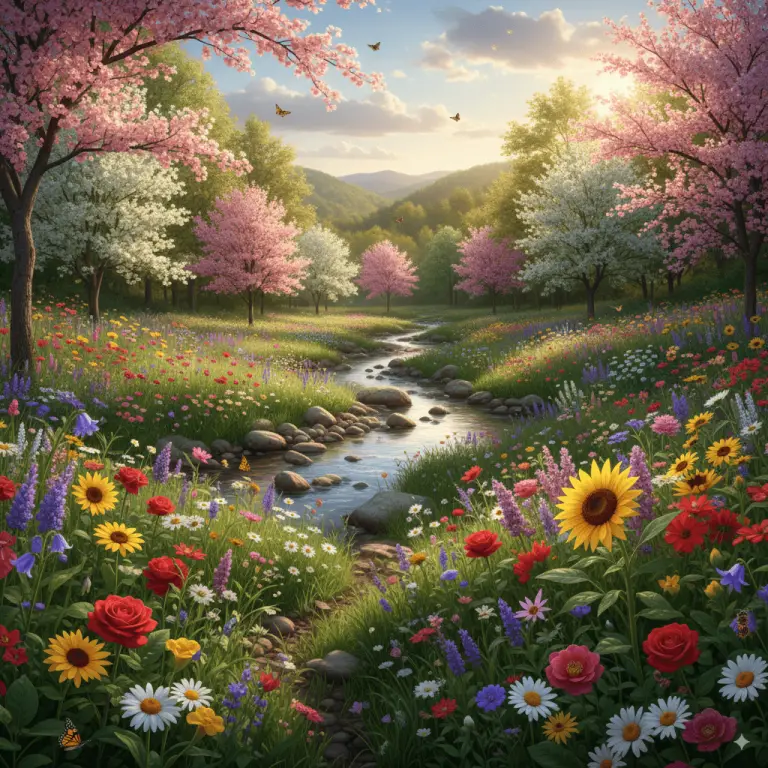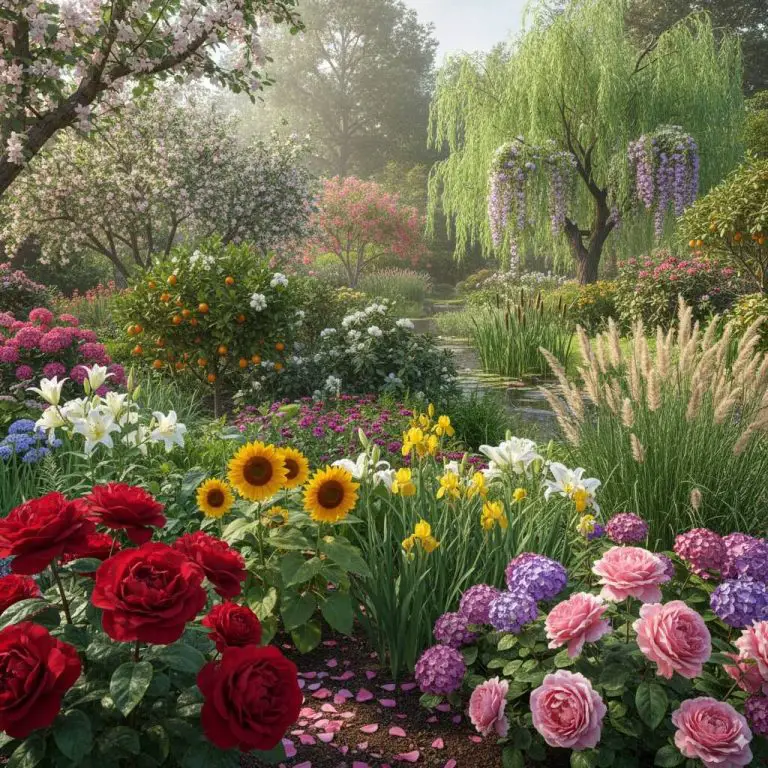All About Flowering Plants – Your Complete Guide To A Blooming Garden
Have you ever walked past a neighbor’s garden, bursting with vibrant color, and thought, “I wish I could do that”? It’s easy to feel a little intimidated by the sea of petals and leaves, wondering where to even begin. You might worry that you don’t have a “green thumb” or the time to create a beautiful floral display.
I’m here to promise you that growing a stunning flower garden is absolutely within your reach. With a bit of friendly guidance and the right knowledge, you can transform any patch of soil into your own personal paradise. This comprehensive guide is designed to demystify the process and give you the confidence to succeed.
In this ultimate guide, we’ll walk through everything you need to know, from choosing the perfect plants and preparing your soil to mastering the art of care and troubleshooting common issues. Get ready to learn all about flowering plants and unlock the secrets to a garden that brings you joy season after season.
What's On the Page
- 1 The First Step: Choosing the Right Flowering Plants for Your Garden
- 2 Preparing Your Garden Bed: The Foundation for Healthy Blooms
- 3 Your Essential All About Flowering Plants Care Guide
- 4 Common Problems with Flowering Plants (And How to Fix Them!)
- 5 The Surprising Benefits of All About Flowering Plants
- 6 Frequently Asked Questions About Flowering Plants
- 7 Your Blooming Garden Awaits
The First Step: Choosing the Right Flowering Plants for Your Garden
The journey to a beautiful garden starts with choosing the right companions. Walking into a nursery can be overwhelming, but don’t worry! Understanding a few key categories will make your decisions simple and fun. This is one of the most important all about flowering plants tips I can share: success begins with the right plant in the right place.
Annuals vs. Perennials vs. Biennials
Think of this as understanding the lifespan of your flowers. It’s simpler than it sounds!

🌿 The Companion Planting & Gardening Book (eBook)
Bigger harvests, fewer pests — natural pairings & simple layouts. $6.99
Get – $6.99
🪴 The Pest-Free Indoor Garden (eBook)
DIY sprays & soil tips for bug-free houseplants. $4.89
Get – $4.99- Annuals: These plants live for just one growing season. They sprout, bloom, produce seeds, and then die off. They’re fantastic for providing brilliant, season-long color. Examples: Marigolds, Zinnias, Petunias.
- Perennials: These are the plants that come back year after year. Their roots survive the winter, and they regrow in the spring. They have a shorter bloom time than annuals but are the backbone of a low-maintenance garden. Examples: Coneflowers (Echinacea), Hostas, Daylilies.
- Biennials: These have a two-year life cycle. The first year, they grow foliage. The second year, they flower, set seed, and then die. Examples: Foxglove, Hollyhock, Sweet William.
A great strategy for beginners is to create a garden with a strong foundation of perennials for structure and then fill in the gaps with colorful annuals for non-stop blooms.
Understanding Your Light: Sun, Part Shade, or Shade
This is non-negotiable! Before you buy a single plant, observe your garden space throughout the day. Where does the sun hit, and for how long? Plant tags will give you the exact light requirements.
- Full Sun: 6 or more hours of direct, unfiltered sunlight per day. Perfect for sun-lovers like Sunflowers, Lavender, and Sedum.
- Part Sun / Part Shade: 3 to 6 hours of sun per day, preferably in the cooler morning hours. Great for plants like Bleeding Hearts, Coral Bells, and Astilbe.
- Full Shade: Less than 3 hours of direct sun per day. This doesn’t mean total darkness, just no direct rays. Hostas, Ferns, and Impatiens thrive here.
Placing a sun-loving plant in the shade will result in weak growth and few, if any, flowers. It’s the most common mistake I see, but it’s so easy to avoid!
Go Native: The Eco-Friendly Choice
For a truly sustainable all about flowering plants approach, consider native plants. These are species that have evolved in your local region. They are naturally adapted to your climate and soil, meaning they require less water, no fertilizer, and are more resistant to local pests and diseases. Plus, they are a vital food source for local pollinators like bees and butterflies!
Preparing Your Garden Bed: The Foundation for Healthy Blooms
You wouldn’t build a house on a weak foundation, right? The same goes for your garden. Great soil is the secret to healthy roots, which in turn leads to lush foliage and spectacular flowers. Taking time to prepare your soil is one of the most important all about flowering plants best practices.
Know Your Soil
First, get a feel for your soil’s texture. Is it sandy (gritty and drains fast), clay (heavy and holds water), or loamy (the perfect, crumbly in-between)? Most of us have a mix. You can also get a simple soil test kit from a local garden center to check the pH and nutrient levels. Most flowering plants prefer a slightly acidic to neutral pH (around 6.0 to 7.0).
The Magic of Amending
No matter your soil type, the solution is almost always the same: add organic matter. Compost is a gardener’s best friend. It improves drainage in clay soil, helps retain moisture in sandy soil, and provides a slow-release source of nutrients for all soil types.
Aim to spread a 2-4 inch layer of compost, aged manure, or leaf mold over your new garden bed. Then, use a garden fork or tiller to work it into the top 6-8 inches of soil. This single step will make a monumental difference in your garden’s success.
Your Essential All About Flowering Plants Care Guide
Once your plants are in the ground, the real fun begins! This is where you get to nurture them and watch them thrive. This all about flowering plants care guide covers the three most critical tasks: watering, feeding, and tidying up.
Watering Wisely
Overwatering is just as dangerous as underwatering. The goal is to provide deep, infrequent watering rather than a light sprinkle every day. This encourages roots to grow deeper into the soil, making them more resilient to drought.
- Check the Soil: The best way to know when to water is to stick your finger about two inches into the soil. If it’s dry, it’s time to water.
- Water the Base: Apply water directly to the soil around the base of the plant, not on the leaves. Wet foliage can encourage fungal diseases. A soaker hose is a fantastic tool for this.
- Morning is Best: Water in the early morning so any moisture on the leaves has time to evaporate before the evening, reducing disease risk.
Feeding Your Flowers
If you’ve prepared your soil with plenty of compost, you’ve already given your plants a great start. However, some heavy-blooming plants, especially annuals in containers, benefit from a little extra food.
A balanced, all-purpose flower fertilizer is a great choice. You can use a granular slow-release type that you mix into the soil at planting time, or a liquid fertilizer that you apply every few weeks during the growing season. Always follow the package directions—more is not better and can harm your plants.
The Art of Deadheading
“Deadheading” sounds grim, but it’s simply the process of removing spent or faded flowers. Why do it? A plant’s main goal is to produce seeds. If you remove the old flower before it can make seeds, the plant will redirect its energy into making more flowers! For many plants like Zinnias, Cosmos, and Marigolds, this simple task will keep them blooming profusely all season long.
Common Problems with Flowering Plants (And How to Fix Them!)
Even the most experienced gardeners run into issues. Don’t be discouraged! Knowing how to identify and solve the common problems with all about flowering plants is part of the learning process. Here’s a look at a few frequent culprits.
Pesky Pests
Aphids, spider mites, and slugs are common garden visitors. For an eco-friendly all about flowering plants approach, start with the gentlest methods. A strong spray of water from the hose can dislodge many pests. For more persistent issues, insecticidal soap is a safe and effective option. Encouraging beneficial insects like ladybugs (who love to eat aphids) is a great long-term strategy.
Common Diseases
Powdery mildew is a frequent foe, showing up as a white, dusty coating on leaves. It’s often caused by poor air circulation and damp conditions. The best defense is prevention: give your plants enough space when you plant them and water the soil, not the leaves. If it appears, remove the affected leaves promptly.
“Why Aren’t My Plants Blooming?”
This is a frustrating one! There are a few likely reasons:
- Not Enough Sun: As we discussed, this is the #1 reason. A sun-lover in the shade just won’t have the energy to produce flowers.
- Too Much Nitrogen: If you use a fertilizer that’s too high in nitrogen (the first number on the bag), you’ll get lots of lush, green leaves but very few flowers. Switch to a balanced fertilizer or one higher in phosphorus (the middle number).
- Needs More Time: Some perennials, especially when newly planted, may take a season or two to get established before they put on a big floral show. Be patient!
The Surprising Benefits of All About Flowering Plants
Gardening is so much more than just pretty flowers. Embracing this hobby brings a wealth of rewards that extend beyond your backyard. Understanding the benefits of all about flowering plants can deepen your appreciation for every seed you sow.
Your garden becomes a bustling ecosystem. Flowers provide essential nectar and pollen for bees, butterflies, and hummingbirds, supporting these crucial pollinators. You’re not just growing plants; you’re creating a habitat.
The act of gardening itself is a proven stress-reliever. It connects you to the natural world, provides gentle physical activity, and gives you a profound sense of accomplishment as you watch your garden grow and change. It’s a beautiful way to practice mindfulness and care for your own well-being.
Frequently Asked Questions About Flowering Plants
What are the easiest flowering plants for a beginner?
Don’t worry—these flowers are perfect for beginners! For annuals, you can’t go wrong with Zinnias, Sunflowers, Marigolds, and Cosmos. They grow quickly from seed and are very forgiving. For easy perennials, look to Coneflowers (Echinacea), Black-Eyed Susans, and Daylilies. They are tough, reliable, and come back every year.
How often should I fertilize my flowering plants?
It depends on your soil and the type of plant. If you amended your soil well with compost at the start of the season, many plants in the ground won’t need any extra food. For heavy feeders like annuals in containers or hanging baskets, a liquid fertilizer every 2-4 weeks during peak growing season is a good rule of thumb. Always read the product label.
Can I grow flowering plants in pots?
Absolutely! Container gardening is a fantastic way to enjoy flowers on a patio, balcony, or front step. Just make sure your pot has drainage holes. You’ll also need to water and fertilize plants in pots more frequently than those in the ground, as the soil dries out faster and nutrients are limited.
Your Blooming Garden Awaits
We’ve covered a lot of ground, from the first exciting step of choosing your plants to the nurturing rhythm of watering and care. Remember that gardening is a journey, not a destination. This all about flowering plants guide is your starting point, but the greatest teacher will be your own garden.
Don’t be afraid to experiment, to move a plant that isn’t happy, or to try something new next year. Every season brings new lessons and new joys. The most important thing is to get your hands dirty and have fun.
So go forth, plant with confidence, and get ready to enjoy the incredible beauty you’ve created. Your vibrant, blooming garden is waiting for you.
- Cucumber Plant Diseases Treatment – Your Guide To Spotting And - November 7, 2025
- Can You Cut Back Cucumber Plants – A Gardener’S Pruning Guide For - November 7, 2025
- How To Cut An English Cucumber For A Continuous Harvest - November 7, 2025



